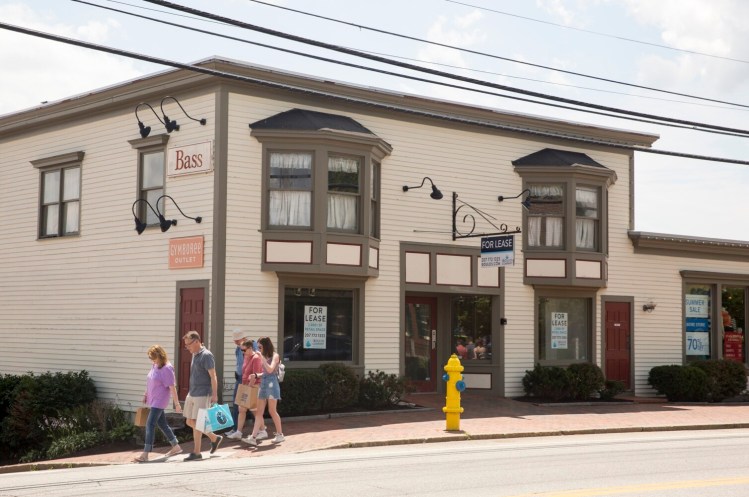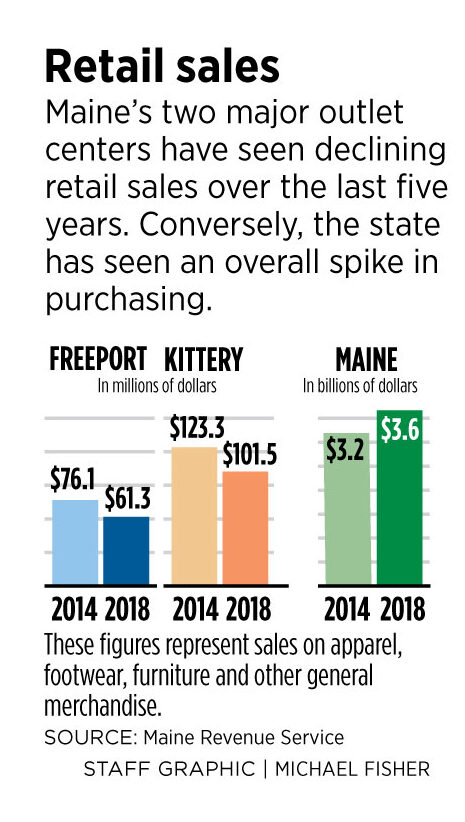A transformation in retailing is creating unwelcome changes in Maine’s two leading towns for outlet shopping.
Both Kittery and Freeport have seen sharp sales declines in the past five years. In Kittery, sales of general merchandise – a category that includes clothing, footwear and furnishings – are down nearly 18 percent from 2014 to 2018, from $123 million to $101 million, according to sales tax data. In Freeport, the drop in sales in that category was even sharper, almost 20 percent, from $76 million to $61 million.
For Maine as a whole, general merchandise sales rose 13 percent, from $3.2 billion to $3.6 billion, during the same period.
The declining sales in the outlet hubs likely reflect the shift in shopping from bricks-and-mortar stores to online, said Curtis Picard, president and chief executive officer of the Retail Association of Maine. It’s part of a national trend. In February, online retail sales overtook in-store sales for the first time ever nationally, the U.S. Department of Commerce reported.
“Consumers are using all the channels available to them” and, for many, that means forgoing a trip to an outlet in favor of online shopping from home, Picard said.
That trend creates challenges to the communities that host outlets, since outlets draw shoppers who eat at local restaurants, book rooms in local lodgings and provide jobs. Freeport and Kittery are responding with new ways to diversify and stabilize their outlet hubs.
The declining sales in outlet towns go beyond clothing and footwear, categorized for state tax purposes as “general merchandise.” Figures on taxable sales from Maine Revenue Services, the state tax agency, show a decline in another category called “other retail,” which captures sales of specialty items, such as sporting goods, and items sold in drugstores and jewelry stores.
In Kittery, those sales dropped nearly 2 percent from 2014 to 2018, while sales in Freeport in that category were off nearly 3 percent during the same period. L.L. Bean’s flagship store in Freeport is classified as “other retail” for sales tax purchases.
But statewide sales in that category shot up 34 percent from 2014 to 2018, suggesting that sales in the outlet towns are lagging far behind.
A NEW KIND OF TENANT
Not surprisingly, tumbling sales in outlet towns are being watched closely by municipal officials, and prompting some innovative responses.
“Concern over the transition of brick-and-mortar retail is something all of us shopping destinations feel very keenly,” said Kelly Edwards, executive director of Visit Freeport, a marketing association and information bureau for the town.
Edwards said the town’s response has been to fill as many vacant storefronts as it can with Maine-based stores, which are likely to be less affected by national trends in online shopping. More than a dozen Maine-owned businesses have moved into town over the past year, she said.
That is helping stem a rise in storefront vacancies. Freeport’s retail vacancy rate is currently above 8 percent, said Keith McBride, executive director of the Freeport Economic Development Corp., well above the southern Maine average of 5 percent.
The rate in Freeport is lowest along Route 1 south, at about 6.32 percent, and highest – 13.7 percent – along lower Main Street, which is south of the downtown village section. The rate in the village itself is nearly 8 percent, where there are about a dozen vacancies, said McBride.
The town’s biggest draw, L.L. Bean, still brings customers to the company’s complex of stores on Main Street in the heart of the village. And Edwards said Freeport also has stores operated by other outdoor gear suppliers, making the town “the perfect place to gear up” and to market itself as a gateway to the Maine outdoors.
In Kittery, officials are thinking of taking a different tack to encourage vibrancy in its outlet centers – creating housing on part of outlet mall property.
Tom Emerson, a member of the town’s economic development committee, said he sometimes takes his morning walk through the outlet malls to “count the number of vacant storefronts,” normally reaching about a dozen. “I’ve lived here 25 years and I’ve never seen so many vacant.”
Although the sales drop-off doesn’t have an immediate tax impact on Kittery – Maine towns and cities don’t get a cut of sales tax paid by shoppers – it might at some point, Emerson said. The concern is that Simon Properties, the owner of many of the strip malls where the outlet shops are located, might seek a property tax abatement if the stores are vacant for long.
And, Emerson said, outlet shopping has a strong seasonal component.
“On a Tuesday morning in February, there’s nobody at the outlet malls,” he said.
Changing the zoning to allow mall owners to create apartments will bring in new residents and could provide more and steadier foot traffic for existing stores, he said. The residents could also attract commercial tenants that don’t face online competition, such as barbershops or fitness centers, which would also diversify the offerings of the outlet malls.
One thing Emerson knows for sure is that Kittery doesn’t need more tourist attractions.
“We’re not very aggressively looking at replacing it (vacant stores) with some other form of tourist occupancy,” he said. “We’re probably as touristed-out as we can handle.”
MORE COMPETITION FROM EVERY DIRECTION
There are other forces restraining sales at outlet centers. One is a trend among national retailers to abandon outlet centers as a conduit for excess inventory in favor of simply selling those items online.
That trend was cited in a recent earnings report from Simon Group, the parent company of Simon Properties. The company, which manages centers in Kittery and 68 other locations around the country, noted that many of its tenants have excess space, caused in some cases by bankruptcies among national retailers and in other cases by retailers opting to use e-commerce to distribute merchandise rather than maintain an outlet store.
Freeport is facing a particular challenge from Portland. Jill McGowan, a women’s clothing store, recently closed its Freeport store and relocated to downtown Portland, said Peter Harrington, a broker and partner with Malone Commercial Brokers.
Harrington said he’s also working with another retailer, whom he declined to identify, looking to do the same thing, but “down here (in Portland), there’s almost no retail space available.”
Portland is attracting more national retailers to the Old Port, Harrington said, pointing to Anthropologie and Urban Outfitters. The city’s reputation as a restaurant mecca also helps attract travelers headed elsewhere in Maine who might bypass Kittery or Freeport, he said.
A major outlet shopping center recently opened in Wareham, Massachusetts, with upscale stores that will likely divert consumers from south of Boston away from a trip to Maine for back-to-school shopping, a traditional draw for the outlets in late summer, he said.
“People are getting cut off at the pass,” Harrington said.
From the north, a weak Canadian dollar isn’t helping outlet centers, either.
Although many Canadians prefer to shop name brands and recognize the outlets as a good source for deals, the Canadian dollar is worth less than 80 cents in America, said Picard, and that exchange rate tends to discourage cross-border shopping trips.
ATTRACTING SHOPPERS
Still, outlets are a draw for many.

Helen Martenn, 83, of Mount Sinai, N.Y., waits for her tour bus to pick her up from outside L.L. Bean on Main Street in Freeport. She enjoys shopping in stores and online, she said. Brianna Soukup/Staff Photographer
Helen Martenn, 83, of Mount Sinai, New York, took in some sun on a recent summer afternoon in front of Bean’s flagship store. She wasn’t looking for outdoor gear, but had purchased a lightweight sweatshirt at Bean. However, she passed on a trek to the company’s outlet store with some friends and instead sat on a bench while she waited for her tour group’s bus to take her back to Long Island.
Her group had come to Maine for four days, most of them spent in the midcoast, Martenn said. The trip to Freeport was the last stop on the trip.
“It’s a very well-kept town, very lovely,” she said of Freeport.
Martenn said she likes shopping, but mostly does it close to home or online.
“If I’m well enough, I prefer to do it by myself,” she said.
Nearby, Claire Oliver, 16, of Cumberland was shopping with a friend. She said she goes to Freeport regularly in the summer, but frequents the Maine Mall in South Portland the rest of the year.
Oliver, unlike many her age, said she prefers to shop in person, rather than online, and so she enjoys a walk around Freeport in the warm weather.

Claire Oliver, 16, of Cumberland said she likes to shop in Freeport in the summer, but tends to frequent the Maine Mall the rest of the year. Brianna Soukup/Staff Photographer
Freeport’s McBride is counting on the town’s appeal to keep drawing visitors.
“What keeps people coming to Freeport is it’s more experiential,” he said. Hotels and inns in town are still filled in the summer, even if the tourists aren’t coming back with as many shopping bags at the end of the day.
“Freeport is already a destination,” he said. “It’s how we continue to enhance that – that’s the most important thing for us right now.”
Send questions/comments to the editors.





Comments are no longer available on this story